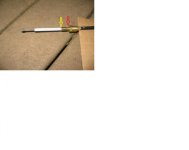This has zero to do with your shift resistance issue. I think that you're on the right track and that you will find the culprit.
*****************
The OEM adjustment procedure, and the suggested measurements, are for an average installation by an average person and/or an average mechanic.
The actual goal is to ensure that the lower shift cable sets the Dog Clutch "sliding sleeve" (while in absolute Neutral) centered equally between each driven gear "dog clutch" engagement teeth. In other words...... with all of the shift components in the Neutral position, the sliding sleeve should be positioned at an equal distance from gear engagement.
Here is a simple tried and proven technique that works for both the Merc A drive and the Cobra drive.
This has been geared towards the OMC Cobra drives, however the principle is very similar for the Merc A drives.
The OEM engineers chose an initial cable adjustment dimension for average Joe mechanic and average Joe user. Hence the
initial adjustment "Tool" and the measurements.
This gets us close ONLY.... and perhaps may be subject to further adjustment.
The whole idea is to center the Dog Clutch "sliding sleeve" equally between the two driven gear Dog Teeth while in neutral.
The pre-determined dimension (the tool) gets you close ONLY, since each scenario may be slightly different.
You can either begin with the suggested OEM dimension, or you may want to begin from scratch.... your call:
1. With the drive fully down (to counter gravity against the sliding sleeve), have a helper swing the propeller back and forth (right and left)
quickly, and in an even pattern and rhythm.
2. You will be at the engine with the lower shift cable disconnected at the linkage arm.
3. As you bring the cable towards a FWD gear engagement, note where you just begin to hear the "ratcheting" sound as the sliding sleeve contacts the FWD gear Dog Teeth. Note where the cable is in it's travel, and find a way to mark it.
4. Now move the cable towards a REV gear engagement. The helper will still be swinging the prop back/forth using the same rhythm.
Again, note where you just begin to hear the sliding sleeve contact the REV gear Dog Teeth.
Note once again where the cable is in it's travel, and find a way to mark it.
5. When you divide this cable travel equally, you will have located theoretical Neutral regarding where the sliding sleeve is in relationship to the
two "driven" gears.
6. Now connect your lower shift cable up to the rest of the linkage so that this "Neutral" travel adjustment is maintained.
The spring loaded cam arm will have maintained it's neutral position.
You may find that the new measurement is slightly different from that of the OEM (or Stuart Hastings dimension for the OMC Cobra drives).
None-the-less, the sliding sleeve will now be at center of travel while in Neutral on the splines of the propeller shaft.
Again, this is the goal!
7. Make your Merc SI or your OMC ESA adjustments after first doing the above.
The final Merc SI or the OMC ESA adjustment must be made while on the water as to acquire the necessary prop thrust resistance.
NOTE: this method works well if all is in good condition. If you have a bad cable, bent shifting rod, or any other items that are not working correctly, it will prevent most any method from working as it should.
.



